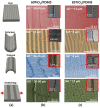Mechanically Switchable Wetting Petal Effect in Self-Patterned Nanocolumnar Films on Poly(dimethylsiloxane)
- PMID: 34685004
- PMCID: PMC8538580
- DOI: 10.3390/nano11102566
Mechanically Switchable Wetting Petal Effect in Self-Patterned Nanocolumnar Films on Poly(dimethylsiloxane)
Abstract
Switchable mechanically induced changes in the wetting behavior of surfaces are of paramount importance for advanced microfluidic, self-cleaning and biomedical applications. In this work we show that the well-known polydimethylsiloxane (PDMS) elastomer develops self-patterning when it is coated with nanostructured TiO2 films prepared by physical vapor deposition at glancing angles and subsequently subjected to a mechanical deformation. Thus, unlike the disordered wrinkled surfaces typically created by deformation of the bare elastomer, well-ordered and aligned micro-scaled grooves form on TiO2/PDMS after the first post-deposition bending or stretching event. These regularly patterned surfaces can be reversibly modified by mechanical deformation, thereby inducing a switchable and reversible wetting petal effect and the sliding of liquid droplets. When performed in a dynamic way, this mechanical actuation produces a unique capacity of liquid droplets (water and diiodomethane) transport and tweezing, this latter through their selective capture and release depending on their volume and chemical characteristics. Scanning electron and atomic force microscopy studies of the strained samples showed that a dual-scale roughness, a parallel alignment of patterned grooves and their reversible widening upon deformation, are critical factors controlling this singular sliding behavior and the possibility to tailor their response by the appropriate manufacturing of surface structures.
Keywords: GLAD coatings; PDMS; anisotropic wetting; droplet sliding; self-surface patterning.
Conflict of interest statement
The authors declare no conflict of interest. The funders had no role in the design of the study; in the collection, analyses or interpretation of data; in the writing of the manuscript; or in the decision to publish the results.
Figures




Similar articles
-
Black Silicon/Elastomer Composite Surface with Switchable Wettability and Adhesion between Lotus and Rose Petal Effects by Mechanical Strain.ACS Appl Mater Interfaces. 2017 Sep 27;9(38):33333-33340. doi: 10.1021/acsami.7b11143. Epub 2017 Sep 13. ACS Appl Mater Interfaces. 2017. PMID: 28901732
-
Mechanical Strain Induced Tunable Anisotropic Wetting on Buckled PDMS Silver Nanorods Arrays.ACS Appl Mater Interfaces. 2015 Apr 29;7(16):8419-26. doi: 10.1021/acsami.5b01530. Epub 2015 Apr 14. ACS Appl Mater Interfaces. 2015. PMID: 25844957
-
Switchable Wettability and Adhesion of Micro/Nanostructured Elastomer Surface via Electric Field for Dynamic Liquid Droplet Manipulation.Adv Sci (Weinh). 2020 Aug 2;7(18):2000772. doi: 10.1002/advs.202000772. eCollection 2020 Sep. Adv Sci (Weinh). 2020. PMID: 32999834 Free PMC article.
-
Wetting on silicone surfaces.Soft Matter. 2024 Jul 10;20(27):5273-5295. doi: 10.1039/d4sm00346b. Soft Matter. 2024. PMID: 38952198 Review.
-
Anisotropic wetting surfaces with one-dimensional and directional structures: fabrication approaches, wetting properties and potential applications.Adv Mater. 2012 Mar 8;24(10):1287-302. doi: 10.1002/adma.201104618. Epub 2012 Feb 9. Adv Mater. 2012. PMID: 22318857 Review.
Cited by
-
Multifunctional Biomimetic Composite Coating with Antireflection, Self-Cleaning and Mechanical Stability.Nanomaterials (Basel). 2023 Jun 13;13(12):1855. doi: 10.3390/nano13121855. Nanomaterials (Basel). 2023. PMID: 37368285 Free PMC article.
References
-
- Rahmawan Y., Xu L., Yang S. Self-assembly of nanostructures towards transparent, superhydrophobic surfaces. J. Mater. Chem. A. 2013;1:2955–2969. doi: 10.1039/C2TA00288D. - DOI
-
- Holmes H.R., Böhringer K.F. Transporting droplets through surface anisotropy. Microsyst. Nanoeng. 2015;1:15022. doi: 10.1038/micronano.2015.22. - DOI
-
- Lee S.G., Lim H.S., Lee D.Y., Kwak D., Cho K. Tunable Anisotropic Wettability of Rice Leaf-Like Wavy Surfaces. Adv. Funct. Mater. 2013;23:547–553. doi: 10.1002/adfm.201201541. - DOI
Grants and funding
LinkOut - more resources
Full Text Sources

